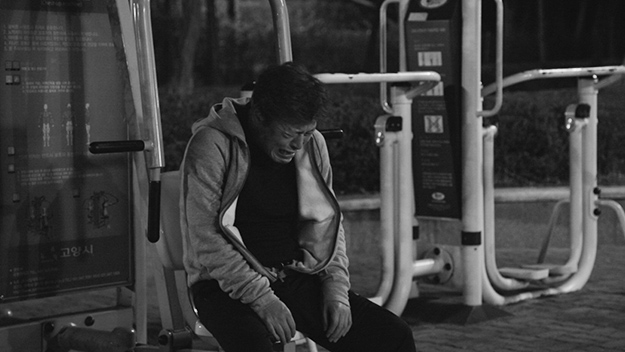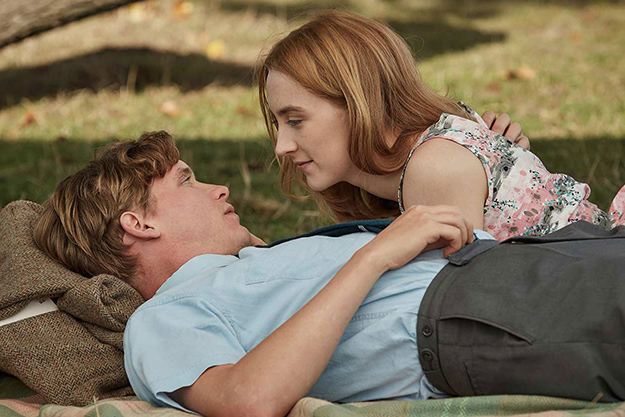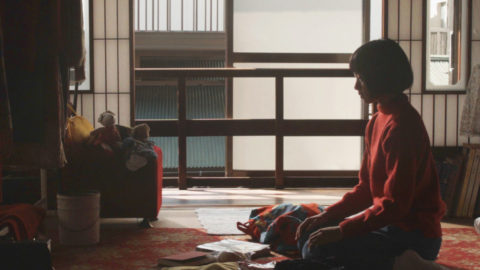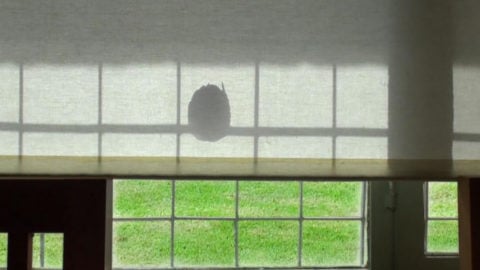Word Pictures: The Day After, with The Seagull and On Chesil Beach

The Day After
Much of Hong Sangsoo’s The Day After (2017) takes place in a publisher’s office crammed with paper—manuscripts stacked on the floor, books piled on tables and shelves. The film itself, like the office, is small, densely layered, and packed with words. People talk over meals, cups of coffee, and far too many bottles of soju (the story is, among other things, a wry commentary on the dangers of the Korean tradition of mixing work and booze). They talk about books and the struggle to write, about the deaths of family members, about philosophies of life, about trivialities, and about the drama that takes over four lives—a love triangle that entangles an innocent bystander. The exchanges are often awkward, lopsided, hesitant, or repetitive, but they are threaded through with subtle comedy and studded with raw anguish. Even text messages are rendered in melodramatic voiceover. Like a play read on a bare stage, the conversations are nakedly exposed by their banal settings: the over-lit office, booths in dingy hole-in-the-wall restaurants. The black-and-white cinematography evokes sharp, dry winter air and a drab, hard-edged urban environment.
Ironically, the character whose words reveal the least is the successful, middle-aged writer and publisher Bongwan (Kwon Hae-hyo), who, like so many of Sangsoo’s men, exhibits male pattern selfishness and irresponsibility. When his wife confronts him with her suspicion that he is cheating, he refuses to say anything, slurping his soup impassively. When his mistress drunkenly calls him a coward, he is briefly roused to angry defensiveness, but then subsides again, sitting silently with eyes averted as she wails in a restaurant. With his new assistant, Areum (Kim Minhee), on her first day on the job, he asks oddly personal questions and makes inappropriate remarks (complimenting her hands as she types), but reveals nothing about himself. When she turns the tables, asking him, “Why do you live?” he has no answer, and dismisses such soul-searching by insisting that words have nothing to do with reality.
Their subsequent debate about whether it is possible to know reality sounds like Philosophy 101, but it neatly frames their characters. Bongwan is vaguely cynical, or cynically vague, a man without principles and almost without qualities. Areum’s articulation of what she believes in gives her a seriousness, a kind of moral standing, that makes her the film’s central consciousness, even as she explains that she sees herself as “not the leading character” or master of her fate—which accurately describes her position as she stumbles into the heated conflict between her boss, his wife, and his mistress.

The Seagull
Those two women prove to be no less self-centered than he is—just more assertive and, in a term that gets thrown around a lot, “shameless.” The wife (Jo Yoon-hee), having found a love poem written by her husband, barges into the office to physically and verbally assault Areum, assuming she must be the poem’s subject. In fact, she has just been hired to take the place of Bongwan’s previous assistant and lover, Changsook (Kim Sae-byeok), who promptly returns, wanting her job back, and convinces him that they should take advantage of his wife’s mistake and use Areum as a decoy. He goes along spinelessly, handing out lies and half-hearted apologies; more than once, he breaks down under strain and exhaustion in helpless sobs. His passivity calls to mind a line from Chekhov’s The Seagull, when the famous writer Boris Trigorin, torn between two women, succumbs to his older mistress’s blandishments and admits, “I have no will of my own . . . I’m flabby and weak. I always submit. How could any woman love me?”
In Michael Mayer’s new film adaptation of The Seagull, scripted by Stephen Karam, Trigorin’s self-accusatory line ends more provocatively, “Is that what women really want?” Chekhov’s play is about the intractability of unrequited love, the agony of artistic failure, the casual and senseless wounds that life’s winners inflict on its losers, as well as old age, illness, and suicide. It is subtitled, “A Comedy in Four Acts.” Chekhov’s tone is famously hard to render on stage or screen, precariously balanced between humor and tragedy, detachment and deep feeling. Mayer’s film is beautifully acted by Annette Bening, who plays up the vanity, vitality, and instinctive cruelty of the aging actress Irina Arkadina; Corey Stoll, warm-eyed and charming as the intelligent yet selfishly weak-willed Trigorin; Elisabeth Moss as a wonderfully dry, mordant Masha (she who famously wears black “in mourning for my life”); Billy Howle as the passionate, painfully vulnerable and insecure young writer Konstantine; and Saoirse Ronan as the naïve but strong-willed Nina. As many writers have noted, the main flaw of this handsome film is that it works much too hard to be cinematic: rapid, jumpy editing and a needlessly mobile camera merely distract from dialogue and performances that need no embellishment, and work against the feeling of stasis and enervated languor that are essential to a play set on a provincial estate from which only a few of the characters manage to escape. Ultimately, some stylistic excesses and deep cuts to the script don’t stop the play from engrossing and shattering the viewer.
But it is entirely through Chekhov’s words and characters that it does so. Though perhaps few would deny that a good script is the essential skeleton without which a film cannot stand or move, still the compulsion to be overtly cinematic is understandable given the disdain for “filmed plays” and “literary” movies. Ever since silent films gave way to sound in the late 1920s, it has been an article of faith among many filmmakers and cinephiles that movies are a visual medium, that talk is secondary at best, a subtraction from the ideal of pure cinema. (As an aside, Chekhov wrote The Seagull in 1895, the year of the Lumière Brothers’ first programs of projected films, and it is a nice touch in Mayer’s film that Konstantine’s disastrous experimental play is presented as a kind of proto-cinema shadow theater using a white sheet; the kindly doctor Dorn defends him as a writer who “thinks in images.”) But words themselves can be cinematic when they create a distinctive tone and rhythm that define a film as much as its look; and when they function as a counterpoint to images, leaving gaps to be filled or projecting pictures in the mind’s eye separate from those on the screen.

On Chesil Beach
In The Day After, people talk at length while the camera just sits and watches them, shifting unobtrusively from one to the other rather than cutting between close-ups in standard shot/reverse shot fashion. As a result, the actors are often filmed from slightly oblique angles, and the space between them is carefully preserved, as is the silence and the time they have to fill. This plain style is paired with an unconventional method of cutting back and forth between the present and the past without any device to indicate the shift in time. The effect is quite different from traditional presentations of flashbacks, for instance in The Seagull, which has been re-structured to begin near the end, with the characters reunited at Sorin’s deathbed, and the bulk of the play unfolding as an extended recollection; or in Dominic Cooke’s On Chesil Beach, which pairs Howle and Ronan again in an adaptation of Ian McEwan’s 2007 novel. Here, a newlywed couple’s disastrous wedding night in a seaside hotel is intercut with a series of flashbacks, and even flashbacks within flashbacks, filling in their courtship and events in their earlier lives. The distinction between now and then is always plain, and increasingly poignant, as the excruciating tension of the virginal couple’s awkward, fumbling attempt to consummate their marriage on an obscenely crimson bed is juxtaposed with their charmed and charming romance, conducted amid the honeyed stones and misted meadows of Oxford.
By contrast, in The Day After, there are no visual or tonal cues to indicate shifts in time, no sense that the past is irrevocably past. Bongwan’s commute to work in the pre-dawn winter darkness is spliced together with memories of a return home, also in the wee hours, staggering drunkenly on the shoulder of his young mistress, embracing her in the bleached, numbing fluorescent light of a vestibule. The shuffling of time schemes continues throughout the film: Bongwan’s lunch with Areum is followed by a flashback to lunch with Changsook at the same table. The two women almost seem to be inhabiting the same space in the office, a doubling effect that steadily hints that the boss may have the same designs on Areum that he had on his previous employee. This simple and at times disorienting technique suggests that the past is still present, and builds a theme of déjà vu that is reinforced by repetitions. For instance, Bongwan is told twice, at the start of the movie and the end, “Your face has changed.” In an epilogue, the film jumps forward to an unspecified future date, and a near-exact replay of an earlier conversation leads to a revelation of how far apart two people can be in their memory of the same events. This comes as an anticlimax after a scene where Areum, finally going home after her harrowing day, finds a moment of grace in a taxicab, gazing through an open window at the falling snow.
A literary device, the epilogue often becomes a temptation to add one more twist, or to over-explain. On Chesil Beach is badly served by its elaborate two-part coda, which jumps ahead from 1962 first to 1975 and then to 2007, resolving the painfully muddled conflict with contrived incidents and cornball epiphanies—in effect, treacly strings added to what is meant to be a lingering chord of overwhelming regret. Up to this point, the film, scripted by McEwan, is mostly pitch-perfect in its portrait of a world of repression and innocence, politeness and snobbery, deeply civilized and intellectually alive yet blighted by embarrassments and frozen silences. It is not hard to fall in love with the central characters, Florence (Ronan), a classical violinist, with her limpid eyes and clarity of purpose, and Edward (Howle) with his shaggy bangs, knowledge of birds, and love of rhythm and blues. That they are so articulate and enamored with each other’s minds makes their breakdown all the sadder. It isn’t their bungling in bed that tears them apart but their inability to talk about it without blame, panic, and unforgivable insults, hurled at each other on a symbolically barren and windswept stretch of pebbled beach. Their tragedy is not a failure of bodies, but of words.
Imogen Sara Smith is the author of In Lonely Places: Film Noir Beyond the City and Buster Keaton: The Persistence of Comedy, and has written for The Criterion Collection and elsewhere.







